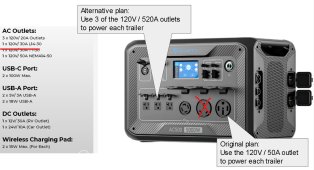ForestBaker
New Member
Hello! I'm new at this stuff and would love some advice on whether I'm going to have issues with "power factor correction" when using the 120V/50amp outlets on the Bluetti AC500's.
My plan was to power 2 trailers on our remote property with the following setup (I've already purchased all of this):
I was going to run long cables from the two trailers to the AC500s (housed in a shed) and plug them into the 120V/50A RV outlets.
However, I was just warned that because the AC500 is only pushing out 120V (I guess the normal is 240V for RV outlets), I might have issues with "power factor correction". And this could cause the following:
Thanks in advance!
Forest

My plan was to power 2 trailers on our remote property with the following setup (I've already purchased all of this):
- 2 Bluetti AC500 inverters
- 7 Bluetti 300S batteries
- 3K watts of solar power
I was going to run long cables from the two trailers to the AC500s (housed in a shed) and plug them into the 120V/50A RV outlets.
However, I was just warned that because the AC500 is only pushing out 120V (I guess the normal is 240V for RV outlets), I might have issues with "power factor correction". And this could cause the following:
- Some appliances, like the mini split, not turn on or shut off
- This will cause more heat in the cables/wiring and wear out the appliances faster (sounds kinda scary)
- Scrapping the entire Bluetti system (ouch!) and go with inverters that can push 240v to each trailer
- Look into incorporating "ferrite b, passive" hardware that might reduce the power factor issue
- Use 3 separate 120v/20amp outlets on the AC500 to power each trailer, instead of the single120v/50amp outlet. We haven't built the panels on the trailers yet, so this could be an option.
Thanks in advance!
Forest

Last edited:


